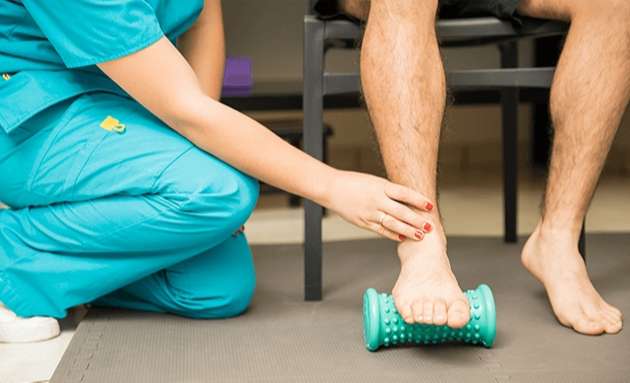Running Injuries Explained: Plantar Fasciitis

If you experience a sharp, stabbing pain in one or both of your heels when you step off your bed as soon as you wake up in the morning, you may have developed a condition that is called 'jogger's heel' or plantar fasciitis.
The plantar fascia is a band of shock-absorbing tissue that stretches like a set of bow-string across the bottom of your foot, connecting your heel bone to your toes. When this tissue is inflamed, it causes pain in the heel or near the arch of the heel. This pain dulls gradually during the day, and during exercise, but returns towards the end of the day, or if you have been on your feet for too long.
Plantar fasciitis is more common among runners and athletes, but it is also a cause of heel pain among the over-40s and can sometimes be misconceived as a heel spur. Your doctor may recommend an X-Ray, ultrasound scan of the fascia, or an MRI scan to get a clearer diagnosis so as to recommend the appropriate treatment.
Causes and Risk Factors Leading to Plantar Fasciitis
Here are some risk factors for Plantar Fasciitis
- Overstretched fascia and ligament tension or a tight Achilles heel tendon.
- Obesity can lead to small tears on the stretched fascia due to weight-bearing stress.
- Trauma to the heel or foot, through injury.
- Sports activities, such as running long distances, ballet dancing, aerobic dancing or jumping can increase the risk of damage to your plantar fascia.
Pain Relief and Treatment
The obvious symptom of plantar fasciitis is heel pain, especially in the mornings and at night. This is because the Achilles heel tendon connected to the plantar fascia tightens when you sleep.
If left unchecked and untreated, the pain does heal by itself over a few months. However, if the pain is getting worse because your job requires you to be on your feet for most of the day, or if you are an athlete and require immediate pain relief, it is advisable to see a doctor at the earliest.
Depending on the factors causing your pain and its severity, your doctor or physical therapist may advise you to:
- Rest, and apply cold compress with ice around the area, followed by heat compresses at equal intervals during the day to ease the inflammation.
- Soak your feet in warm water with Epsom salts, as well as massage.
- OTC pain relief medicines for inflammation could be taken. Please check with your doctor for specific drugs safe for you.
- Wear supportive insoles for the arch of the foot, supportive trainers, custom-fitted arch supports, or night-time splints to stretch your calf and the arch of your foot while you sleep.
- Consult your physician for further steps like surgery if your pain persists for more than 12 months.
As an athlete, if you have experienced heel pain or plantar fasciitis earlier, it is always advisable to take preventive measures so it does not re-occur or develop into a chronic condition.
Four Tips to Prevent Heel Pain
Here are a few tips, as well as some exercises to treat plantar fasciitis:
- Remember to stretch your plantar fascia and Achilles heel tendon before you begin running or exercise.
- Avoid exercising with bare feet on hard surfaces.
- Wear shoes that provide good support for your arches and cushioning for your heels.
- Use appropriate shoes for walking and running, and change them regularly.
Four Exercises to Treat Plantar Fasciitis
- Place both your arms on a wall and stand 40 cms away from it with your feet slightly apart. Place your right foot in front of the left and bend it slightly, letting the calf muscles tighten on your straight left leg. Keep the position for a while and relax. Repeat 10 times, before switching the legs and position.

- Stand on the bottom of the staircase and hold the stair rails for support. Position your feet slightly apart and let your heel hang just slightly over the edge. Lower your heels, taking care not to bend your knees. Keep this position to feel the stretch in your calf muscles for about 20 seconds, relax, and repeat six times. Continue this exercise twice a day.

- Sit with your legs straight in front of you. Loop the base of your right foot with a band or towel, and try to bring your toes towards you without bending your knee. Hold this position for 30 seconds and repeat this exercise with the other foot.

- Remove your footwear and sit on a chair. Place a rolling pin, a soft but firm ball, or a can under your foot and roll the arch of your foot over the object in different directions for some time. Try to do this exercise at least twice a day.
Plantar fasciitis can be a painful and annoying condition. However, it has been observed that a reduction in repetitive and strenuous exercises or switching to low-impact activities like swimming can improve the symptoms significantly. Regardless of whether you are an athlete or a non-sportive person, ensure you wear the right shoes that support and cushion your heel at all times.






